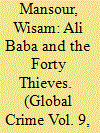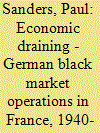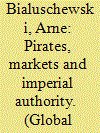|
|
|
Sort Order |
|
|
|
Items / Page
|
|
|
|
|
|
|
| Srl | Item |
| 1 |
ID:
080633


|
|
|
|
|
| Publication |
2008.
|
| Summary/Abstract |
The twelfth-century Abbasid Caliphate was riddled with criminal gangs, corrupt officials and shadowy figures who spanned both, with underworld figures such as the notorious Karahanli family able to operate with virtual impunity. In this context, rather than being a fable in which good triumphs over evil, 'Ali Baba and the Forty Thieves' one of the later narratives of The Arabian Nights, depicts organised crime in Baghdad during the twelfth century and how a more cohesive gang can replace another, using ruthlessness and guile. As such, a close analysis of the tale and also those issues it does not discuss suggests striking continuities between medieval and modern organised crime.
|
|
|
|
|
|
|
|
|
|
|
|
|
|
|
|
| 2 |
ID:
080635


|
|
|
|
|
| Publication |
2008.
|
| Summary/Abstract |
From the eighteenth century onwards, the state took increasing responsibility for controlling activities within its borders. Prior to this, however, the role of the state was less clearly defined. In the early modern period, with Europe dominated by expansionist Empires comprised of loose collaborations of national groupings, state borders were often not clearly defined, and inadequately policed or protected by the central state. Thus, as well as the persistent threat of large-scale military invasion, frontier or borderland regions also became hotspots for cross-border banditry, smuggling and piracy, often on a well-established and semi-professional scale. As a result, border communities were often co-opted by the state to act as 'border guards', by policing and defending the state frontiers, in return for certain 'privileges', despite the fact that, in some instances, these border communities were known to participate in large-scale criminal activities themselves. By considering and comparing three separate border communities: the Cossacks of Southern Russia (fifteenth to eighteenth centuries), the Uskoks of Dalmatia (sixteenth and seventeenth centuries) and the Chods of Bohemia (twelfth to seventeenth centuries), and their involvement with large-scale cross-border criminal activities, this article will draw a number of general conclusions about the nature of crime in state border regions and the complicity of the state in many aspects of organised crime during the early modern period
|
|
|
|
|
|
|
|
|
|
|
|
|
|
|
|
| 3 |
ID:
080640


|
|
|
|
|
| Publication |
2008.
|
| Summary/Abstract |
Study of the black market is vital to understanding the social, economic and political stakes of the occupation in the Second World War. It allows a re-examination of German occupation policy, but also highlights civilian survival strategies, wealth distribution and the changing occupier - occupied relationship. In France, the German occupiers spent at least 15% of all financial resources made available to them through the Vichy occupation levy on the illegal market. This purchasing started from the onset of occupation and until the December 1941 resource crisis; German economic agencies bought 'anything, at any price'. This uncoordinated bidding led to a black market bubble, the effects of which spilled over into the official markets where they caused havoc. Spring 1942 brought the centralisation of purchasing. During the ensuing second phase (until spring 1943), the occupier still bought 'anything', but no longer at 'any price'. Although this stabilised prices, it also encouraged illegal production, with raw materials diverted from official industry allocations. During this period 50-60% of all Vichy occupation payments were spent on the black market, at a strategic juncture of the war when such extravagance was no longer justifiable. This undermined German finances in France and became a liability to exploitation and collaboration. The third phase of black market exploitation, from summer 1943 to the end of the occupation, was the most rational. The Germans restricted purchasing to genuinely indispensable strategic raw materials. This built on the effective implementation of a German black market purchasing ban in spring 1943, the support of the Vichy government and French industrial leaders for economic collaboration, business concentrations and closures, market monitoring and resource management methods. As a result, the illegal market in the industrial economy was largely controlled. Arguably the same degree of economic mobilisation could have been achieved one or even two years earlier, had the Germans abstained from unilateral black market purchasing and instead heeded Vichy calls for closer cooperation. German failure in this area was due to lack of coordination, institutional chaos, economic dilettantism, endemic corruption and reckless resource competition; all have their origin in the structure of the Nazi system. Illegal food markets, on the other hand, demonstrated the limits of coercion. As the nutritional value of official civilian rations remained below subsistence level, the French continued to depend on the illegal market for sustenance. Evading food restrictions became something of a national pastime. This further compounded Vichy's lack of willingness (and authority) in enforcing economic regulation in the countryside.
|
|
|
|
|
|
|
|
|
|
|
|
|
|
|
|
| 4 |
ID:
080639


|
|
|
|
|
| Publication |
2008.
|
| Summary/Abstract |
Ringvereine were officially chartered associations of ex-convicts which, on paper, provided mutual aid and promoted the cultural activities of their members. In reality, they promoted their members' criminal activities in various ways and acted as professional associations of criminals, which set and enforced rules and provided members with contacts, assistance and status. At least in certain areas, namely prostitution and racketeering, the Ringvereine may also have functioned as criminal organisations with direct involvement in criminal activities. Using data obtained from a systematic analysis of various contemporary newspapers and periodicals, and from a review of secondary sources, primarily comprising journalistic and law enforcement accounts, this study examines their structure, function, geographical scope, membership characteristics and ties to legitimate institutions and highlights major phases and turning points in their history which spans an era from the late nineteenth to the mid-twentieth century. It is argued that the Ringvereine constitute a deviant case in the history of German organised crime, which otherwise has been characterised more by informal and fragmented offender structures embedded in deviant subcultures
|
|
|
|
|
|
|
|
|
|
|
|
|
|
|
|
| 5 |
ID:
080641


|
|
|
|
|
| Publication |
2008.
|
| Summary/Abstract |
This paper traces the history of international police cooperation through the development of collaborative initiatives that various police actors have introduced since the mid-nineteenth century to address transnational crime on a multilateral basis. The beginnings of international police cooperation efforts were largely rooted in anti-anarchist policies pursued by European governments in order to protect the status quo. Police collaboration largely halted during the world wars, but the second half of the twentieth century witnessed an explosion of international cooperation mechanisms in policing as most states came to recognise the importance of multilateral action against transnational crime. International policing now encompasses sophisticated, official and far-reaching channels of information exchange and joint policing strategies and operations. Police cooperation has gone through cycles, however: the political motivation that originally encouraged foreign police agencies to share information on alleged perpetrators and their activities in due course took second place to specifically criminal investigations, but in today's security-driven policy environment the political dimension is once again on the rise, as police strategies are aimed at terrorist groups
|
|
|
|
|
|
|
|
|
|
|
|
|
|
|
|
| 6 |
ID:
080637


|
|
|
|
|
| Publication |
2008.
|
| Summary/Abstract |
Conventional chronologies of the history of organised crime in America tend to focus on the arrival of large numbers of Italian immigrants in the 1890s as the catalyst for organised crime. However, analysis of the history of interactions between colonists and aboriginal peoples in North America suggests a much earlier incipience of organised criminal activity marked by the arrival of different groups of immigrants, namely, Dutch, French and British colonists to the American north-east. Drawing upon primary documents describing the practices of early trading companies and their representatives, as well as of later land transactions, the authors will present evidence and argument asserting not only a longer history of organised crime in North America but also an explanation for the inadequacy of the paradigm that governs much current organised crime and transnational organised crime research.
|
|
|
|
|
|
|
|
|
|
|
|
|
|
|
|
| 7 |
ID:
080634


|
|
|
|
|
| Publication |
2008.
|
| Summary/Abstract |
The ancient Aztecs created the largest empire in the prehistory of Mesoamerica. During this brief period (1428-1521 AD), Aztec life was complex and volatile. This article treats the place of crime and deviance within this dynamic setting, exploring (1) the Aztec historical and institutional context for living a proper (and improper) life, (2) recorded and expected realms of criminal and deviant behaviour, (3) opportunities for malfeasance and those who took advantage of them and (4) the manner in which Aztec institutions and powerful individuals dealt with crime and deviance. These dimensions provide the basis for an explanatory discussion of the presence or absence of organised crime in Aztec life
|
|
|
|
|
|
|
|
|
|
|
|
|
|
|
|
| 8 |
ID:
080636


|
|
|
|
|
| Publication |
2008.
|
| Summary/Abstract |
This article argues that during the years 1716-1726 diverse groups of maritime predators operated opportunistically across the spectrum from state-sanctioned privateering to outright piracy. All of these freebooters relied on access to markets if they were to survive in an increasingly hostile political environment. Merchants as well as colonists in various parts of the Atlantic World profited from their connections to marauders. It was only possible to successfully suppress piracy in the 1720s when the colonial authorities managed to close their ports to pirates
|
|
|
|
|
|
|
|
|
|
|
|
|
|
|
|
| 9 |
ID:
080638


|
|
|
|
|
| Publication |
2008.
|
| Summary/Abstract |
Organised crime in Russia draws upon a rich, anarchic and dangerous tradition rooted equally in the problems in policing this sprawling, impoverished and authoritarian empire and the folkways of the town and the village. Historically, two distinct criminal traditions emerged. In the countryside, the problems of overcoming peasant resistance (especially evident through their samosud lynch law) and trafficking in identifiable loot meant that gangs of horse thieves became increasingly organised in the nineteenth century. This proved an evolutionary dead end, though, and the real ancestors of the modern Russian 'mafiya' are to be found in the vorovskoi mir, the 'thieves' world', which formed in the slums of the cities as a result of the urbanisation and industrialisation of the late nineteenth and early twentieth centuries. This became an increasingly homogeneous and organised underworld culture, with its own hierarchies, values and spoken and tattoo languages. By the beginning of the twentieth century, the hard core members of the vorovskoi mir were deliberately embracing their status as outsiders and beginning to assert their dominance of the prison system, something which would later bring them into contact with the Soviet state. This led to an internal revolution which left them willing and able to operate within the confines of an increasingly corrupt USSR, ready to capitalise on the collapse of the Soviet system.
|
|
|
|
|
|
|
|
|
|
|
|
|
|
|
|
|
|
|
|
|